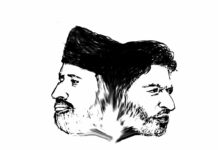Basharat Ali
The creation of APHC has a shady and ambiguous history. Multiple narratives thrive as what led to the creation of an amalgam drawn from disparate social, political and religious organisations with divergent objectives to form an ‘umbrella organisation’ for achieving the right of self-determination according to United Nations Security Council Resolutions. Many analysts and Hurriyat critics see its creation as a handiwork of internal and external parties, agencies and political players who, in one way or the other, claim representation of the people of Kashmir. From Pakistan’s Inter Services Intelligence (ISI) to the mystery-of-sorts role played by America, Hurriyat’s creation has been viewed through the prism of doubt, almost always.
JKLF presented an ideological challenge to the Indian state which had so far hoodwinked people of Kashmir through the hollow rhetoric of plebiscite. The following years of armed insurrection witnessed a war in Kashmir with Indian army and other armed forces engaging in torture, rape, killings, enforced disappearances and extrajudicial killings, all under the legal cover of Armed Forces (Jammu and Kashmir) Special Ordinance 1990 (known as Armed Forces Special Powers Act), giving them extraordinary powers to shoot and kill, search and arrest without warrant with immunity from prosecution.
The emergence of APHC as a political face of the independence movement was therefore necessitated by the situation on ground, not to completely ignore the role of external agents. However, its creation came with some serious flaws and mistakes. The fundamental flaw was the confluence of ideologically disparate units. The divergent political and religious ideologies are certain to render any movement or organisation vulnerable to schism and factionalism. APHC is no exception. It split twice. Today, three mutually exclusive parties claim to be ‘real’ Hurriyat, the real representatives of the people of Kashmir. One headed by Syed A li Geelani is called Hurriyat (G); the second one led by Mirwaiz Umar Farooq calls itself APHC while as in media it is known as Hurriyat (M) and another, the recent faction, is headed by Shabir Shah and Nayeem Khan – Hurriyat (JK).
The imature decision in the creation of APHC was the appointment of young Mirwaiz as its chairman. His political position was always under the ‘cloud of suspicion’. With subtle political agenda, his role as a chairman was only ‘symbolic in nature’. After four years when Mirwaiz resigned, it was initially seen as a normal transition of power but it later transpired that it was a result of internal fissures in APHC as the chairman had offered unconditional talks with New Delhi. His adventure, the open letter to the people of India, again, clearly demonstrated his inconsistency.
The third flaw in APHC was the use of United Nations Security Council Resolutions (Adopted on April 21, 1948, after hearing arguments from India and Pakistan, the UN Commission was instructed to visit subcontinent and help the governments of India and Pakistan restore peace and order in the region and prepare for a plebiscite to decide the fate of Kashmir. The resolutions were passed under Chapter VII of UN charter as its primary objective and also the much (ab)used phrase “will of the people” to decide the fate of Kashmir.
We have witnessed a barrage of criticism made against Hurriyat lately both on the social media and popular press. Much of this criticism stems from cynicism rather than pragmatism. However, certain issues have been rightly highlighted and point at the failures of the pro-freedom groups. Like the localisation of protests — seen recently in case of Tral and Budgam — raise some questions on the working of Hurriyat and its coordination with people. Again, one must understand how state propaganda to malign the resistance leaders works. There are people who are dedicated to do rumour mongering and make conspiracy theories. The “soft-separatist” posturing by PDP is a calculated move to side-line the resistance leaders and Hurriyat needs to step up.
Hurriyat needs to overhaul its organisational structure and try to unify all its splinter groups to shape a common agenda.
The author studies Conflict Analysis and Peace Building at Nelson Mandela Centre for Peace and Conflict Studies, Jamia Millia Islamia Central University, New Delhi and can be contacted at [email protected]















